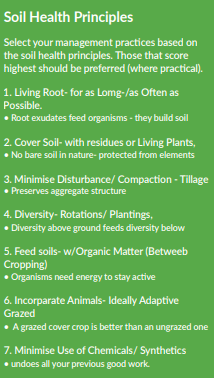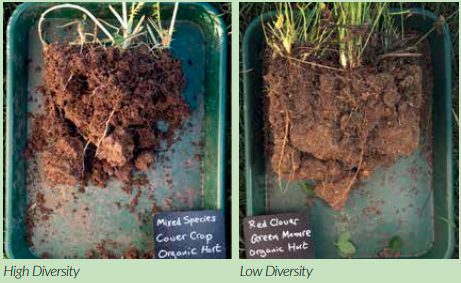Why is it that grass margins are usually in much better heart than the cropped land? Is there something
magical about grass? Field margins in many ways set the bar for soil health on your farm.
But is that as good as it can get? And do we need to go down to grass to achieve it?
“I believe the answer is no” writes Niels Corfield, crop advisor

We can go beyond the grass fallow and achieve good results in a short time frame. Because ultimately when cropping, we have more tools at our disposal. However, we have to employ those tools extensively, and thoroughly, if we’re going to actually see these results on our farms, in any reasonable period.
What are the tools that we have available to us? It’s just going no till, right? Well, basically, it’s the application of all the soil health principles. Mimicking the conditions we find under grass. That said, the acid test is in the soil condition. The good news is that you can actually see soil health. But what does healthy soil look like? Must it be lab tested? No, simply put, aggregation (crumb structure) is that measure. With that said what are the primary rationales for adopting soil health practices? Why should we, as farmers, advisors & land managers care? Are there any production benefits?
Improved soil health basically equates to better crumb structure that’s looser, easier to work and more absorbent. Certainly, the longer a ley is down for the better aggregated the soil becomes. So before we get into the detail, I want to put this in a global perspective. Ultimately, with 4 degrees of lockedin warming, coming down the line, business as usual is not an option. The warming we are dealing with now, as well as that coming means, for example, we can’t rely on rainfall to germinate spring crops, we need to do it with stored soil moisture (another reason not to till). Only improved soil health (crumb structure) can deliver this – so your disk drill can place the seed easily into a porous and moist seedbed.

When it comes to carbon sequestration, soil health practices, of which conservation agriculture (CA) is one example, is the only framework that can deliver the numbers we need to be hitting, under commercial conditions. That said, if we are really going to be able to make the case for soil-based production, we have to be demonstrating significant soil carbon results. Recent data from Brown’s Ranch recorded 96 tons per acre of carbon in the upper 48″ of soil, as compared to 10-35 tons for farms in the region. While there is much controversy around carbon auditing, and it probably isn’t a tool for day-to-day decision-making, these results represent a pretty high bar, and also an indication of what is possible.
Cover Crops
Over-winter cover crops (OWCCs) are the bread-and-butter of CA, they perform a vital role: preserving soil structure, holding onto nutrients, protecting soils etc. And in warm autumns they may actually do some soil building but generally speaking with soil/air temperatures being low and day lengths short, microbial activity is low, and root exudation is minimal. Also when temperatures are low, little or no N-fixation occurs, calling into question the rationale for buying those expensive legume seeds. Beyond these shortcomings, there’s limited species choice and slow growth.

Does this mean we shouldn’t bother with them? No. They still play a vital role in protecting soil & preserving structure. Though that said, where planted too late, or too thinly, OWCCs may not actually give sufficient cover either. But is there a way we can go further with our cover crops and get more pronounced results? Certainly. Spring sown or full season cover crop mixes open up the floodgates for diversity. And with it being in season, there’s plenty of warmth in the soil for optimal microbial activity (soil building), including nitrogen fixation by free living nitrogen fixing organisms, eg azotobacter. The diversity of plants means more specialist organisms should be being well fed through exudates.
But what about the cost of fancy mixes like these? Well, source seed from the feed merchant. A good starting point is bird seed mix. These tend to have at least the 8 species that are suggested as a minimum – getting that diversity lever up to where it wants to be. Just to reiterate the ideal is to have eight or more species from three or more of the functional groups: warm season/ cool season, grasses/broadleaves. The warm season plants are also the C4 plants, eg sunflower, millet, meaning more solar energy capture. Add to this any farm saved seed available. As well as this, include a tall straw cereal, like rye or population wheat – these may well be on the pricier end, so why not grow a strip or two of these as straights for combining for future mixes.
Finally, all of these plants should be annuals as we then have more options for termination, including: rolling and trampling – so long as the planting is fully mature. It’s probably also worth leaving out any short-season inclusions, like: mustard, radish and even buckwheat, since they will shed viable seed long before this termination point, possibly volunteering in subsequent crops. At the end of the season obviously you will always have the option to spray off.
There’s certainly question marks around margin for in-season covers, probably the best return this would be to graze these covers, using low utilisation, ultra-high stock density (UHD) systems. By terminating in this fashion (along with rolling) and with having low utilisation there will be large pulses of root exudates produced during these grazing events. It’s exudates that contribute most directly to aggregation and soil organic matter. Ultimately the payback for root exudation is a steady supply of nutrients in a plant available form, that are free.
Diversity and Cash Crops
Are we limited to soil building under cover crops? No, techniques like: band sowing, strip cropping, inter row planting/undersowing, crop mixtures, intercropping and relay cropping, are all indicated. Simply shifting from a monocrop to a bicrop doubles the diversity. Of these probably the most straightforward is strip cropping. The narrower the strips the better, to ensure the greatest interaction between the crop’s roots. Furthermore, the wider the spacing for the main crop the more a second planting is indicated. It would possible to undersow with a winter wheat (potentially bicropped with a legume) – making this more of a relay crop than an undersowing, and removing at least one spray pass. Basically, do whatever it takes to get diversity into your cash cropping, and to maintain a living root in the ground through more of the year.
Advice for getting started
On small acreages or one field (potentially, close to home), modify your operation to incorporate some of the following (ideally with a commitment for three years minimum):
Cover Crops
Plant a cover crop, properly, with high seed rate, early sowed, and with starter fertiliser. Where cover cropping already, try a diverse mix, 8 species or more, cheap/ farm saved seed. If you’re on the diverse over winter thing, then try it in season, ideally UHD grazed. Drill a cash crop into cover crop residues.
Cash Crops
Diversify the rotation, try a novel crop – maybe a seed crop Strip cropping: could be a header width, or just a drill width (that you then stripper header). Plant an intercrop, a two way mix, with that are co combined.
Niels Corfield is an independent advisor and educator specialising in soil health and regenerative agriculture. Check out his events page at the back of the magazine for upcoming courses or follow the QR Code to book places..
